COOPERATION MODEL
ARTIFICIAL INTELLIGENCE
PRODUCT ENGINEERING
DevOps & Cloud
LOW-CODE/NO-CODE DEVELOPMENT
INDUSTRY
FRONTEND DEVELOPMENT
CLOUD DEVELOPMENT
MOBILE APP DEVELOPMENT
LOW CODE/ NO CODE DEVELOPMENT
EMERGING TECHNOLOGIES







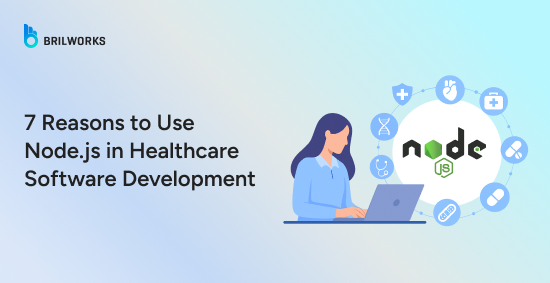
The healthcare industry is racing to keep pace with digital demands, and Node.js is emerging as a go-to technology for building fast, scalable, and reliable applications. Global healthcare IT spending is projected to reach $600 billion by 2027, signaling growing investments in digital solutions. Technology is not only improving patient care but also connecting healthcare providers with patients in remote areas.
This article explores how healthcare professionals can leverage Node.js—one of the most popular technologies for real-time applications today—to develop efficient healthcare solutions. For enterprise-level considerations, Java remains a strong choice, which we discuss in detail the role of Java API in modern development.
Before diving into specific use cases, let’s briefly review why Node.js has become a preferred option for healthcare software development.
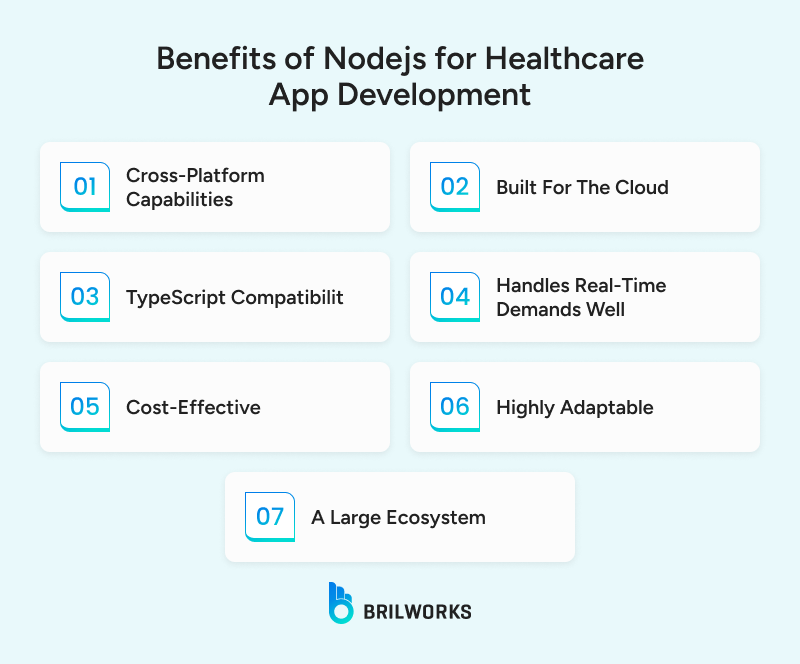
Native development often requires teams proficient in multiple programming languages to target various platforms. Node.js, as a cross-platform runtime environment, allows developers to use JavaScript for both server-side and client-side code. This approach can reduce development costs by 30–60% while enabling code reuse across Windows, macOS, and Linux systems. For more on cross-platform approaches, see native vs cross-platform comparison.
Healthcare systems increasingly rely on cloud platforms for high-performance computing, sophisticated databases, and scalable storage. Node.js integrates seamlessly into cloud-first and serverless environments, supporting data-intensive operations while maintaining flexibility and speed. Node.js currently powers over 30 million websites globally, reflecting its robustness and scalability.
With enterprises prioritizing safer and more collaborative development, TypeScript’s static typing system is gaining traction. Node.js works smoothly with TypeScript, enabling compile-time validation, reducing avoidable bugs, and facilitating scalable enterprise development.
Healthcare applications increasingly rely on real-time interactions. Node.js’ event-driven architecture supports high-speed, bidirectional communication, making it ideal for live patient monitoring systems and telemedicine platforms. Its lightweight, asynchronous design ensures quick response times, even under heavy load.
JavaScript developers are widely available, and Node.js frameworks and libraries accelerate development timelines. Startups and mid-sized healthcare companies can reduce costs without compromising quality. Open-source modules, ready-made solutions, and the npm ecosystem give teams a significant advantage.
Beyond healthcare, Node.js powers IoT systems, fintech platforms, and more. While enterprises may lean toward Java or .NET, Node.js remains a strong choice for agile teams seeking speed, modularity, and scalability.
Node.js is more than a runtime environment. Its package manager, npm, hosts millions of modules. Tools like Electron extend Node.js to desktop software. With a robust community of developers and contributors, Node.js continues evolving with industry needs.
Modern electronic health record (EHR) systems require interoperability across platforms while adhering to FHIR standards. Node.js’ asynchronous processing enables handling multiple queries simultaneously, making it ideal for bridging legacy HL7 v2 systems to FHIR-compliant architectures. This allows developers to modernize infrastructure without rebuilding entire pipelines.
Remote patient monitoring requires processing thousands of device streams in real time. Node.js handles this efficiently, converting raw data into actionable insights quickly, which is critical for proactive patient care.
Telemedicine platforms rely on signaling to exchange session data before initiating video or chat communication. Node.js can handle these signaling events in milliseconds, supporting modern protocols like HTTP/2 and token-based authentication for secure sessions. Development teams can implement HIPAA-aligned solutions without compromising performance.
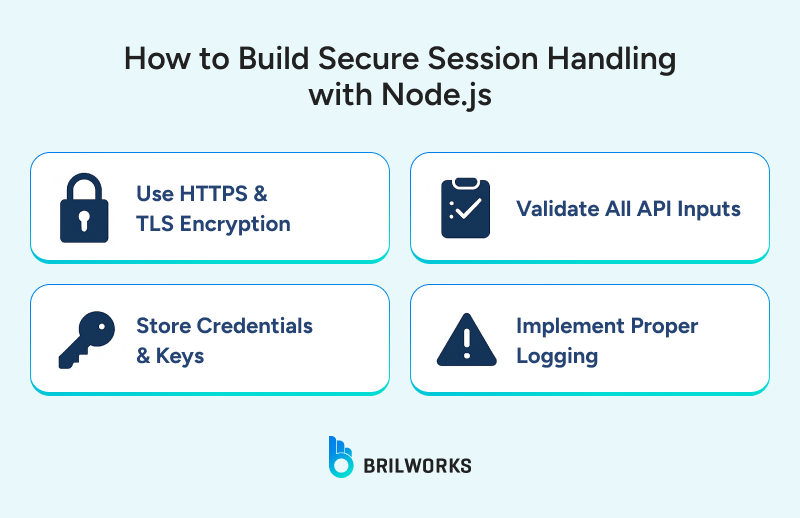
Event-driven Node.js functions enable automated, real-time decision support. By reacting to patient data and events, these microservices enhance efficiency and accuracy in clinical workflows.
Medical imaging often involves large files exceeding half a gigabyte. Node.js can preprocess and extract only the required data, significantly reducing load times and storage demands. It can also route data efficiently across systems using parsers and image conversion tools.
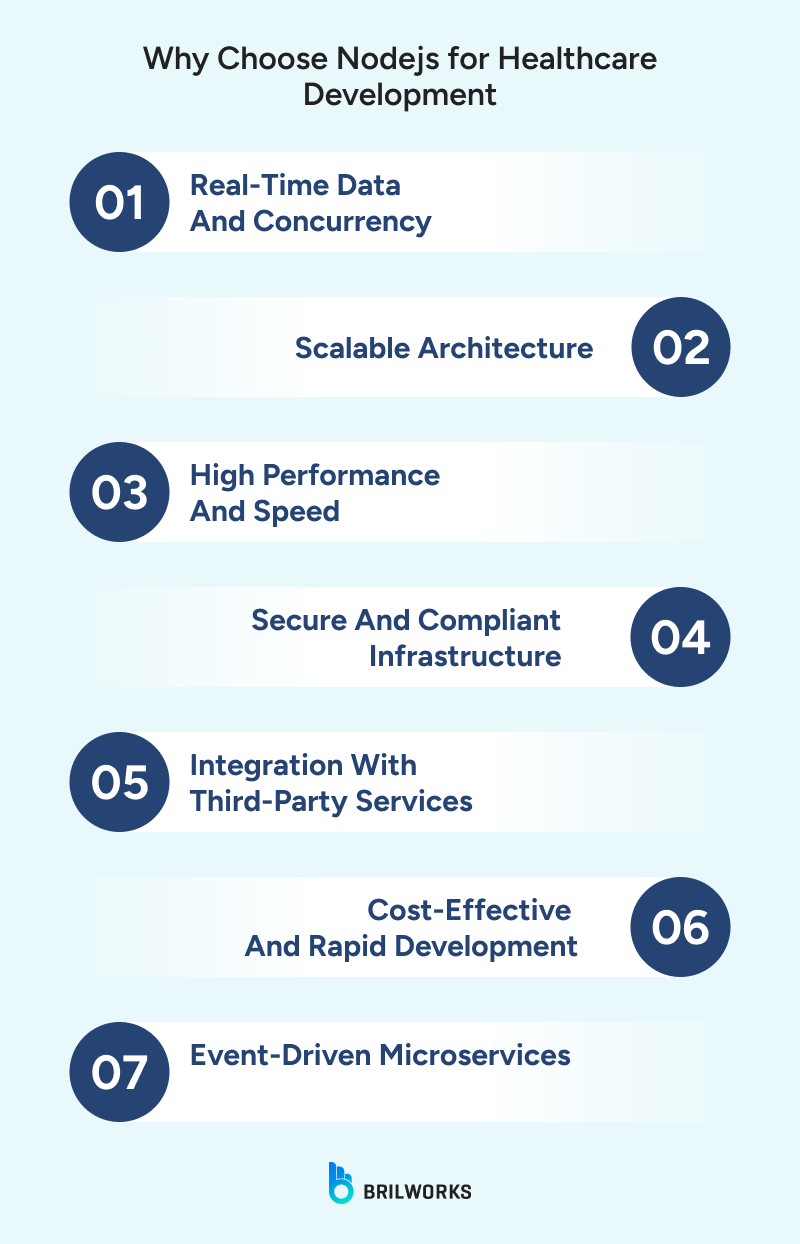
Node.js’ single-threaded, non-blocking architecture ensures real-time responsiveness. This is crucial for:
Patient Monitoring: Continuous streaming of vital signs from devices
Emergency Response Systems: Immediate alerts for critical events
Telemedicine Platforms: Low-latency video consultations
Node.js supports both vertical and horizontal scaling, essential for handling usage spikes during flu seasons or telehealth surges.
Horizontal Scaling: Distribute applications across multiple servers with load balancers or clustering
Vertical Scaling: Efficiently offload tasks while minimizing CPU usage
Powered by Google’s V8 engine, Node.js compiles JavaScript to machine code for faster execution. Concurrent I/O operations reduce latency, enabling responsive applications for large user bases.
Node.js provides tools for secure, standards-compliant applications:
End-to-End Encryption: Protects data in transit and storage using libraries like crypto, bcrypt, and jwt
Role-Based Access: Control access based on user roles with Passport.js or custom RBAC solutions
Secure Sessions: Maintain authenticated session states using packages like express-session
Best Practices for Node.js Healthcare Apps:
Use HTTPS and TLS for all communications
Validate API inputs to prevent injection attacks
Securely store credentials and keys
Implement robust logging and anomaly detection
Node.js simplifies integration with EHRs, pharmacy systems, insurance platforms, and lab systems:
RESTful and GraphQL API handling
HL7, FHIR, and DICOM compliance through libraries
Middleware frameworks like Express and Nest.js for modular integration
Examples include syncing patient data with Epic or Cerner, real-time prescription updates, and insurance claims processing.
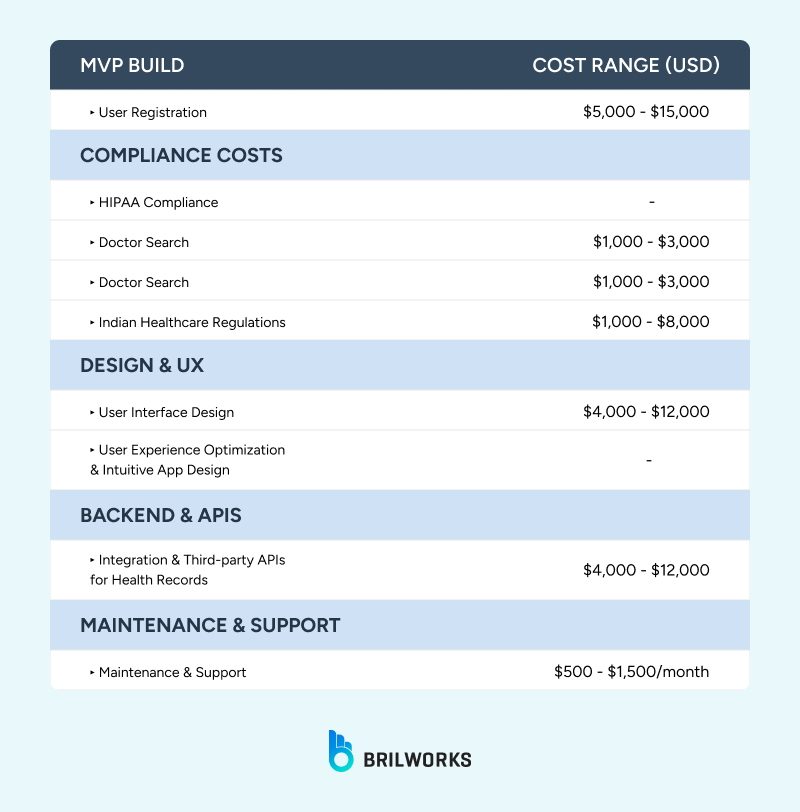
Node.js reduces development costs while accelerating timelines:
Unified JavaScript stack minimizes context switching
npm modules accelerate common healthcare features like notifications or scheduling
Fast prototyping reduces time-to-market for MVPs
Efficient infrastructure reduces server costs
Node.js supports modular microservices for scalable, maintainable healthcare applications:
Modular Services: Independent deployment of scheduling, billing, lab reporting, and patient record modules
Independent Scalability: Scale modules based on usage, e.g., telemedicine modules independently
Enhanced Maintainability: Smaller services reduce dependencies, simplifying updates and feature additions
Node.js integrates well with Docker and Kubernetes for smoother microservices deployment.
Use Express.js for APIs, Nest.js for enterprise applications, and database management tools like Mongoose (MongoDB) or TypeORM (SQL).
Use libraries like Helmet, rate-limiters, and npm audit packages, establish CORS policies, and monitor vulnerabilities regularly.
Create modular, extensible systems with proper documentation and monitoring using tools such as Prometheus or New Relic.
For development support, explore Node.js expert developers to accelerate healthcare software projects.
Healthcare software is evolving rapidly, and Node.js enables the development of real-time, scalable, and secure applications.
From telemedicine platforms to FHIR-compliant EHRs and IoT-based patient monitoring, Node.js offers unmatched speed, agility, and adaptability. Its thriving ecosystem, cloud readiness, and cost efficiency make it a preferred choice for startups and enterprises alike.
Looking to build robust healthcare software? Partner with Node.js expert developers to accelerate your digital transformation while ensuring compliance and performance.
Yes, Node.js can be used to build HIPAA-compliant applications, provided proper security measures—like encryption and access control—are implemented.
Node.js works well for telemedicine platforms, real-time patient monitoring systems, EHR integrations, and patient portals.
Node.js uses asynchronous, non-blocking architecture that helps efficiently manage and process large datasets in real-time.
Node.js offers better real-time performance, while Python excels in data analysis and machine learning. The choice depends on the project's primary focus.
Challenges may include finding developers with healthcare-specific experience or integrating Node.js with older, monolithic systems.
Get In Touch
Contact us for your software development requirements
Get In Touch
Contact us for your software development requirements